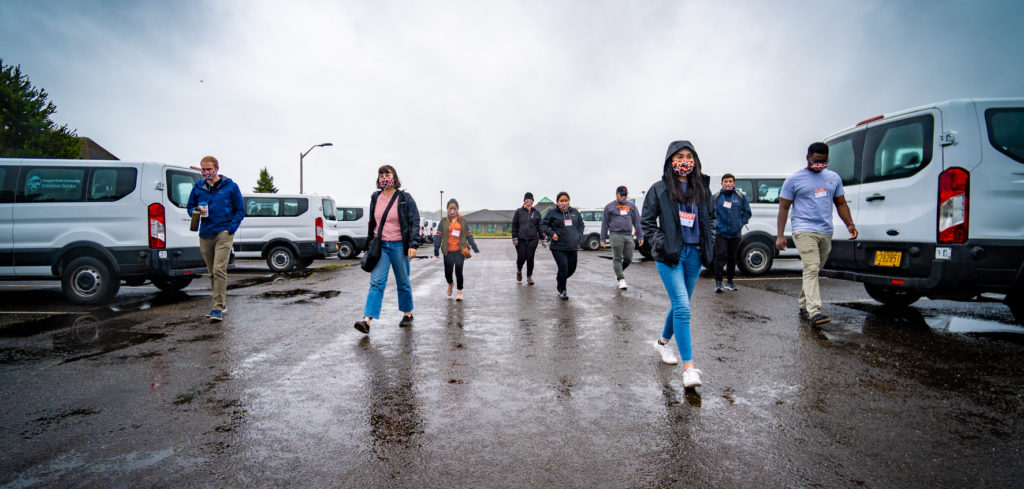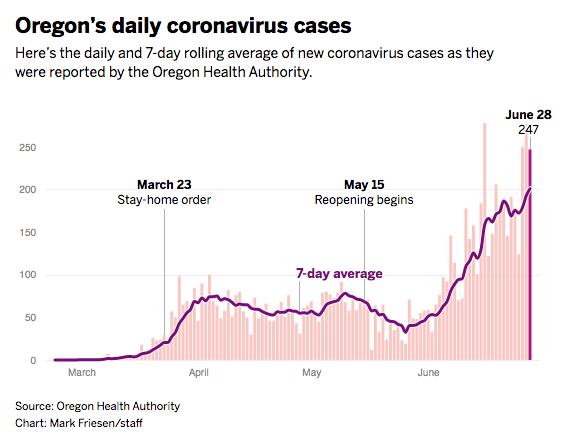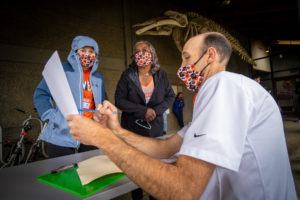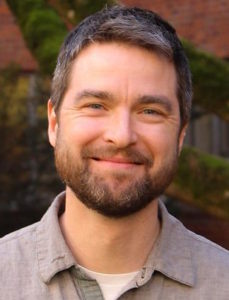
QUINTON SMITH/YachatsNews.com
and STEVE LUNDEBERG/OSU News
Oregon State University researchers are confirming what Newport residents have feared since early June – they have a significant coronavirus problem.
Preliminary results from door-to-door sampling in Newport nine days ago by OSU suggest that 3.4 percent of Newport residents have the coronavirus — at least 17 to 34 times greater than the rate in two other Oregon cities where similar sampling has occurred.
“Our results indicate the virus is relatively prevalent in Newport,” said Ben Dalziel, assistant professor in OSU’s College of Science and co-director of the university’s unique coronavirus sampling project. “This indicates the potential for significant further spread unless strong actions are taken to reverse the course of COVID-19 in Newport.”

Although not unexpected, the results released Tuesday sent another shock through Lincoln County Public Health officials, who are responsible for managing the coronavirus outbreak in the county.
“The OSU TRACE study confirmed what we have been seeing in our case investigations,” said Rebecca Austen, Lincoln County health department director. “We have families without insurance or benefits suffering significant economic hardship. Children and grandparents in families are ill. We as individuals need to buckle down and focus on what we know will prevent the spread of the virus. We as a community need to do our part and protect others by following the guidance we’ve been saying for months — physical distance, protect others with a face covering, and keep clean by washing your hands frequently.”
The testing and results follow the June 7 outbreak at Pacific Seafood’s processing plants along the Newport bayfront, which now numbers 163 cases. The outbreak spread to restaurant workers, forcing at least four Newport establishments to close for days or weeks, and now has led to a growing outbreak in a Newport nursing home.
According to a statewide analyses by The Oregonian, Newport’s 97365 ZIP code has had 246 cases as of last week, the third-most cases in Oregon and the most per capita, with nearly 22 infections per 1,000 people. According to the OSU findings, the actual case rate is 34 per 1,000 people.
Susan Trachsel, spokeswoman for Lincoln County Public Health, said the county and city of Newport will need to ramp up even further its public education campaign encouraging the public to protect themselves.
“We’ll know how we’re doing in a few weeks because it will show up in the hospital system,” Trachsel said. “We had 10 cases a month ago and now we have 310.”
People already seem to be doing a better job following the county’s — and then the governor’s orders — last week requiring face coverings in public in Lincoln County. On Monday the governor expanded that her mask order to the entire state effective Wednesday.

Seafood worker outbreak spurred OSU tests
But it was the large Pacific Seafood outbreak that led OSU to bring its unique coronavirus tracing study to Newport after four weekends of tests in Corvallis and one in Bend. Researchers came to Newport, home of the university’s Hatfield Marine Science Center, on June 20-21.
The project – called Team-based Rapid Assessment of Community-Level Coronavirus Epidemics or TRACE-COVID-19 — conducts random samples of a city’s residents to determine the level of the virus in a community not revealed by regular COVID-19 testing.
TRACE uses a statistical model based on the number of samples, the number of positive tests and prior information on the prevalence of the virus to estimate the proportion of the community that is infected.

In Newport, 30 two-person field teams canvased 30 neighborhoods. Of the households visited, 336 — 71 percent — agreed to participate. Workers received samples from 569 people, and 13 tested positive for SARS-CoV-2, the virus that causes COVID-19. Participants were notified of their test results.
Newport’s population is 10,600, comprising 20 percent of the nearly 50,000 people who live in Lincoln County.
“The high participation rate gives us confidence that our findings are robust and a good indication of how widespread the virus causing COVID-19 is in the general population of Newport,” said Jeff Bethel, an associate professor in OSU’s College of Public Health and Human Sciences and a member of the TRACE leadership team.
Bethel said the number of positive cases reported in the county – 310 total as of Monday – tells health officials how many people are known to be sick with COVID-19. But that number, he said, underestimates the actual number of infected people because it misses asymptomatic individuals, people who have not sought testing, or people who do not have access to testing.
“In contrast, the TRACE estimate of prevalence tells us about the fraction of individuals in Newport who are infected – whether or not they have symptoms, and whether or not they have access to testing,” Bethel said. “Public health and elected officials need this kind of information to plan and deploy resources.”
OSU and county health officials said the results means that Lincoln County residents should especially heed guidance to wear face coverings, to social distance and avoid large gatherings.
Also important is that people who have symptoms or have tested positive follow guidelines to quarantine for 14 days. Lincoln County officials say that has been a problem among low-income workers struggling to support themselves or their families.
TRACE studies in Corvallis and Bend
The TRACE study originated in Corvallis in April and included four weekends of random neighborhood sampling. TRACE moved to include Bend on May 30-31.
Results in both cities estimated an infection rate of 1 to 2 cases per 1,000 residents — or 0.1 to 0.2 percent.

“TRACE does two things,” Dalziel said. “First, we find and get help to participants who are infected but do not know they are, which reduces the chances of these folks unknowingly spreading the virus to other people. Second, we estimate how widespread the virus is in the general population, which informs public health strategies.”
The study was initially funded by OSU and a grant from the David and Lucile Packard Foundation, and has been aided by work from the OSU Foundation and the OSU Alumni Association. Funding from PacificSource Health plans allowed for the expansion to Bend and Newport, and additional sampling in Corvallis.
Lincoln County Commission Chair Kaety Jacobson said the county is interested ways to pay for another TRACE study in the future to determine community spread.
At each home visited by TRACE field workers, members of the household are invited to participate in the study. Participants are given a nasal-swab test kit that they administer to themselves inside their home and their minor children if they want them to take part.
The diagnostic testing component of TRACE operates through a partnership between the Oregon Veterinary Diagnostic Laboratory, which is located at OSU, and Willamette Valley Toxicology.
In addition to TRACE sampling, other OSU researchers collected sewage samples from Newport’s wastewater system the same weekend to test for the coronavirus. Those samples are still being analyzed.
Similar sewer studies are underway in Corvallis, Bend, Washington County and more recently Depoe Bay and Yachats.
Lincoln County offering wide range of resources to help people affected by coronavirus
By STEVE LUNDEBERG/OSU NEWS SERVICE
NEWPORT – Public health leaders in Lincoln County offer a range of resources to help community members in Newport and throughout the county address the risk of COVID-19 and reduce the spread of the novel coronavirus.
Lincoln County Health & Human Services reminds everyone that safety begins with physical distancing, hand washing and the use of face coverings in public spaces. The county will distribute face coverings for free today from 3 to 7 p.m. at nine locations on a drive-through basis.
Information about face coverings, public health services and COVID-19 is available by calling the county’s call center at 541-265-0621 or by emailing LINCOLNCOCALLCENTER@CO.LINCOLN.OR.US. The call center is open weekdays from 9 a.m. to 4:30 p.m., has Spanish speakers on staff and will also provide interpreter services for speakers of other languages.
Anyone who has tested positive for the novel coronavirus, needs help getting access to testing, has been instructed to quarantine or needs assistance of any other kind, including because of feeling anxious or isolated, is urged to contact the call center. People suffering a mental health crisis related to COVID-19 or for any other reason are encouraged to call a counseling center recommended by the county at 866-266-0288.
Symptoms of COVID-19, in addition to fever, cough, shortness of breath, chills, muscle pain, headache, and loss of smell and/or taste, are now known to include abdominal pain, loss of appetite, diarrhea, nausea and vomiting.
If you have had close contact with someone who has tested positive, you should quarantine for 14 days, and get tested if symptoms develop, health officials say.
If you have tested positive, isolate for 10 days from others in your home. If you develop symptoms, isolate for 10 days after the symptoms begin and three more days after they’ve passed.
General information about the virus can be found on Lincoln County Health & Human Services’ COVID-19 web page. The county health department also has a site dedicated to public information updates.
“The results of Oregon State University’s TRACE study in Lincoln County are very concerning and suggest the need for residents to take action to halt the spread of COVID-19,” said Dr. Paul Cieslak, medical director for communicable diseases for the Oregon Health Authority. “If infections in Lincoln County continue to circulate at these rates, far more people risk getting sick. To prevent this, people must take the advice to wear a face covering in public, stay 6 feet apart from people you don’t live with and limit or eliminate any gatherings.
“I also remind people to answer the call if the health authority calls to let you know you may have been exposed to the virus,” Cieslak said, regarding Lincoln County’s contract tracing services.
Samaritan Health Services, which operates a hospital and multiple clinics in Newport, is offering drive-through coronavirus testing in Depoe Bay and Waldport, with a clinician’s order.
Samaritan offers the following guidance to those who want or need a COVID-19 test:
- If you are a Samaritan patient and have a MyChart account, do a MyChart E-Visit, which is free if you choose the visit type “Coronavirus Concerns.” A clinician will review the information you provide and order testing as needed.
- If you are new to Samaritan Health Services, call 855-543-2780. Staff will assist you in creating a MyChart account so you may complete an E-Visit.
- Call your primary care provider so they can assess your symptoms and order testing as needed. Do not go to your primary care provider’s clinic if you think you have coronavirus symptoms.
- If you think you need to go to the hospital, call before going.
- If you have life-threatening symptoms, call 911.
Questions about the Samaritan testing sites can be emailed to COVIDtest@samhealth.org.
Below is a list of other online information pages regarding COVID-19 that Lincoln County residents may find useful. Many are available in multiple languages:
- Know the Facts on COVID-19.
- How to Protect Yourself from COVID-19.
- Physical Distancing.
- Combatting Stigma.
- Resources on Novel Coronavirus COVID-19 from the National Center for Farmworker Health.
The Oregon State University Extension Service is another source of general COVID-19 information in Lincoln County in both English and Spanish. Questions can be directed to Beatrice Botello, program assistant, at Beatriz.Botello@oregonstate.edu.
Botello is involved with a project called Listos, which distributes public health materials among Latinx and Spanish-speaking community members in the county.
Dusti Linnell, OSU assistant professor of practice for Extension in Lincoln and Tillamook counties, is ramping up family and community health communications via social media and radio and through other classes that reinforce guidance from the OHA and the Centers for Disease Control and Prevention. The communications include information about face coverings, physical distancing, limiting social gatherings and high-speed handwashing for workplaces.
“This is the time for all members of the Newport and Lincoln County community to support each other and take part in public health measures to protect themselves and to protect others,” said Javier Nieto, dean of OSU’s College of Public Health and Human Sciences and part of the TRACE leadership team. “Following public health recommendations is the most effective way to keep your family, your friends and the entire community healthy.”



The math in the story about the OSU TRACE study is not correct. Corvallis and Bend had prevalence of 1-2 per 1000. That’s 0.1-0.2%, not 1-2%. Newport has prevalence of 34 per 1000, 3.4%. So Newport has 17-34 times the number in either Corvallis or Bend. It’s bad here. I do want to thank you for your excellent reporting on the COVID situation here in Newport. You have provided information that we haven’t been able to get anywhere else.
Story is corrected now. Thank you!
No where in this study does it show how people/tourists/travelers have brought more cases or to discourage people from visiting!
It will be interesting to see the results from the wastewater treatment sampling to see the prevalence and trends in Yachats. Unfortunately we won’t have the pre-“opening” data to see the impact of visitors/tourists on the village.
Thanks Quinton, your reporting is the best in-depth review of the information on this topic. We are so lucky to have you and Yachats News in our community.